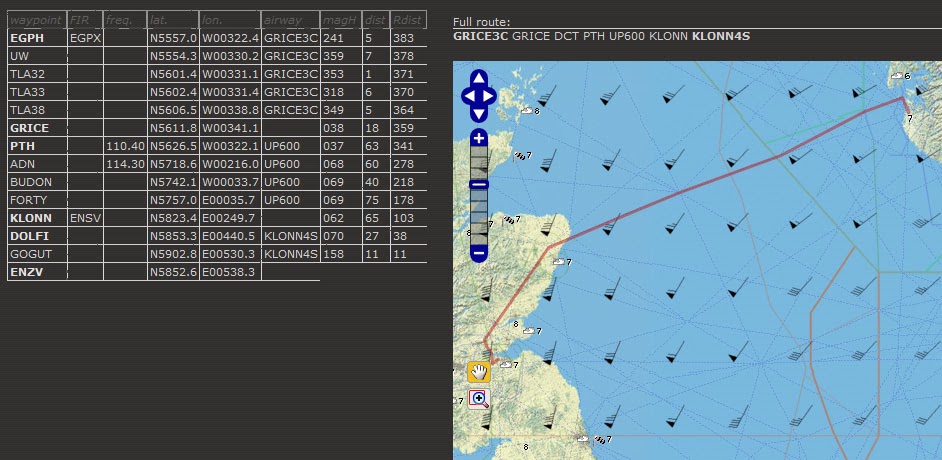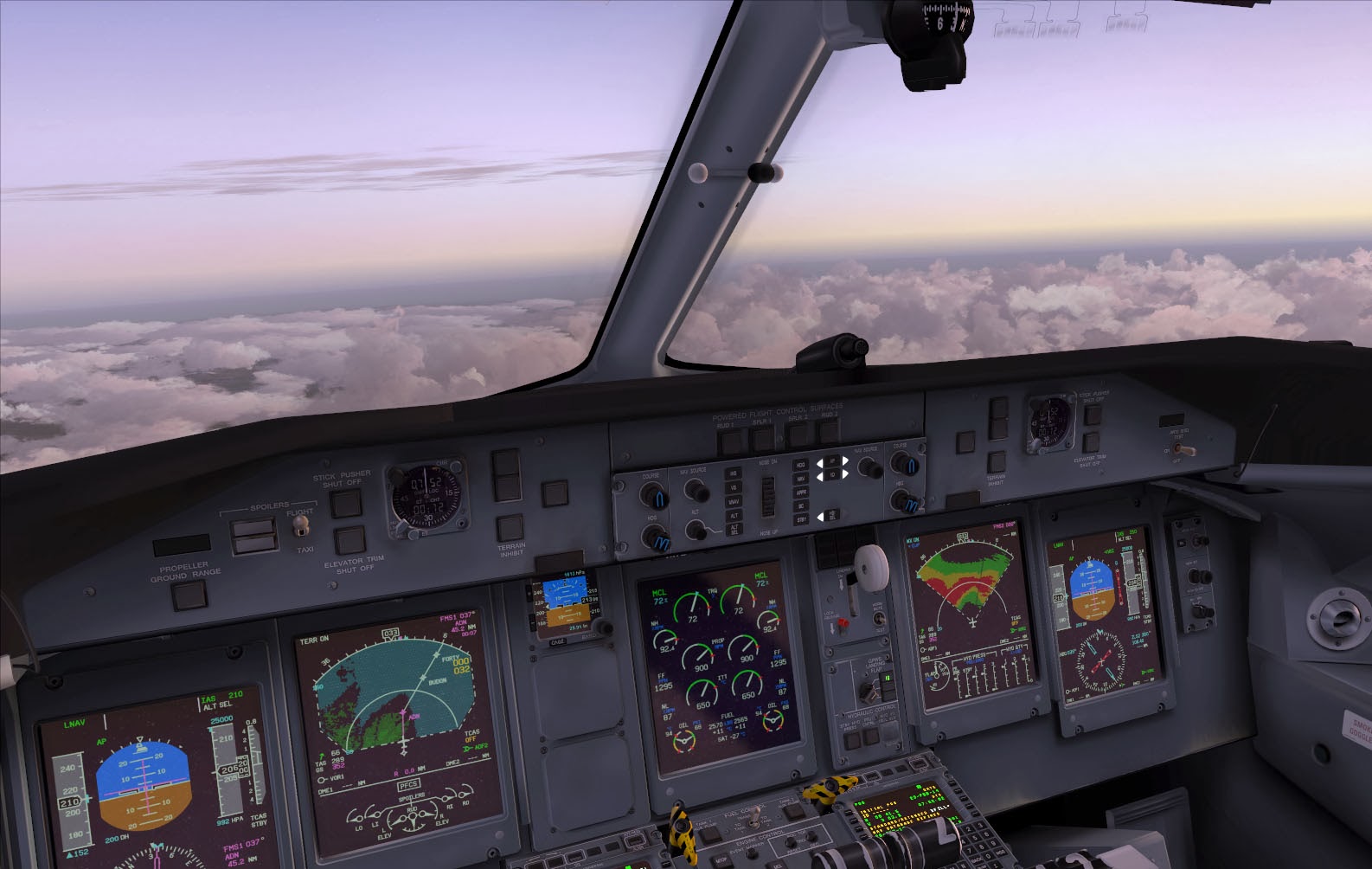A rainy morning at Edinburgh
With a strange obsession, I contemplated landing at Sola Airport (ENZV) in Norway. The thought of landing along a coastline amid fjords and mountains, sounded intriguing. Of course the ever changing bad weather along the Channel could be counted on. With excitement, I planned my Intercity Airways trip from Edinburgh (EGPH) in Scotland, to Sola Airport (ENZV) in Norway.
Flight Plan thanks to Vroute Premium
Flight ICX278 was set to take off from Edinburgh at 7:30 am. At 6:30 am, preparations in the cockpit of the Dash 8 were started. Of course the morning gave the usual British Isles weather of clouds, rain, more clouds, and a bit more rain. While prepping for the flight, heavy rain could be seen pouring over the windshield. My sympathies went out to the ground crew. But for my duties, the projected weather at Sola was of utmost concern. The prediction at Sola was no clouds above 1500 ft and 9999m visibility. This would be perfect for hand flying the Q on final.
GRICE3C on the ND
EGPH ATIS stated that RW24 was in use for landing and departing. Once the basic flight plan was placed in box, I set the departure for RW24 using the GRICE3C SID. This would shoot us North towards the GRICE waypoint, after a sharp turn from our RW24 heading. From there we would head to the ADN Vor. Once there, we would leave merry Scotland, flying over the channel towards Sola. Given the predicted 60 minute cruise time, I did not start browsing the STAR charts for Sola. My guess, given the reported winds at Sola, was that we would be using runway 18.
Leaving the gate after pushback.
At about 7:20 AM we started the push back procedure from EGPH gate 100. With the GPU disconnected, push back began. With the roar of a lion, engine 2 was started. Once the parking break was set and the clearance checked, engine number 1 was started. The sky was now afire with different hues created by the rising Sun. We slowly started our taxi with lights blinking, as we waved goodbye to the RyanAir 737 parked near us.
Windsock at the beginning of RW24
While cruising down the taxiway, a small GA aircraft could be seen landing.
A look at the wind sock at the beginning of RW24 confirmed the fact that we would be taking off into the wind. In the Q, standby hydraulics, auto-feathering, flaps 5, and the weather radar were set. The rain had stopped, as if to say, I will let you pass. Lining up with Runway 24, I gave a brief check of the instruments, PFD, and ND.
Ready for Takeoff!
With taxi light off, landing lights on, I slowly pushed the throttles forward. The turbines came to a loud roar as we accelerated almost a jet speeds down the runway hitting our Vr with quick succession.
Rain with a view.
Climb out was anything but boring! The Q headed up at around 155kts till 1500 AGL was hit. From there, 185kts and 900 rpm were set. Autopilot was then activated allowing the Q to follow the SID. I knew what was coming after a quick glace at the radar. As the Q climbed towards a suspect cloud, rain started to pour at us. All the while the visibility came and went with the drop of the hat. One minute I was getting a nice view of Edinburgh, the next minute it was gone in a haze of white.
By FL100, we were through the thick of it.
By 10000ft we were through the thick of it. The expected ice buildup was detected and steps were taken to combat it. Soon we were on our way towards FL250 leaving the clouds and rain below us.
At FL250, the Q was set for MCR, 850 rpm, and 60% trq. Below the clouds, spots of Scotland could be seen here and there. Soon we hit the ADN VOR, leaving Scotland all together.
While heading across the Channel, the clouds obscured much of our view below.
With a strong 60 kt tailwind, the Q was making very good time. The long 1 hour cruise I predicted, now looked more like 30 minutes. I started to pour over the approach plates and set us for the KLOON3S Star. KLOON3S would takes us northwest of RW 18 at Sola.
The plan was to use the Q’s VNAV to reach 2000ft, 5 nm, before the RANAB waypoint.
This waypoint is directly north of the RW18 ILS. Once free of the cloud deck, I would disconnect the AP and hand fly the approach. Hopefully this could be done the minute I was free of the BKN032 clouds.
ENVZ METAR 1801KT 9999 -RA FEW015 BKN032 07/05 Q1001
You may ask.. “Why hand fly the Q? Why not just use the heading and approach mode to lead straight to the runway, and disconnect at 500 AGL?” My answer would be that I am preparing myself for the times that automation does not work. Our reliance on automation can bite us when we are not prepared. Unfortunately recent real-world accidents have shown this to be true. Yes, automation does have its positives. But to much reliance on automation comes at a cost. In the US, the FAA has stated that it would like pilots to reduce automation when possible. I can tell you, that since I have been spending more time hand flying the Q400 , my compentence with the aircraft has increased.
Descending into sinister looking clouds.
Competence aside, I was faced with a bad feeling in my gut as the Q started the decent. The cloud layer below was so thick that the coast of Norway could not be seen. Thanks to the FMC, the approach was nicely marked on the navigation display. But as the Q flew into the first thick layer of clouds, I felt like Bilbo Baggins from the Hobbit, slowly descending into the dragons layer, not sure what to expect. Before long, all visibility was gone. The autopilot flew the route, as I silently prepared the Q for landing.
Zero visibility before reaching FL100
Now my confidence eroded. "Should I disconnect the AP" "What if there is turbulence" "What about the 19kt headwind on final". Trying to gather my thoughts, I concentrated on slowing the Q down, and preparing the cockpit. Rain started to hit the windshield. Finally, after 3500 feet, the clouds started to breakup and the coast of Norway could be spotted.
The auto pilot is disconnected.
Just as predicted, we were through the thick of it by 2000 feet. Now, only 5 miles from RANAB, I shut off the AP. My hands started to sweat, as they tightly gripped joystick. Flaps and gear were deployed as I slowed the Q, trying to stabilize before the turn to final.
On final for RW 18
Just before RANAB, the turn to final was commenced. The runway was now visual. With intense concentration, the dance began with the trim and throttle lever. Reducing throttle, then adding it, then reducing a bit. The glide slope and papi lights helped guide the descent. The Q hovered around 130 kts on final, smoothly approaching Runway 18. With much ado the Q finally planted its legs on the runway. The reverse thrust and brakes soon brought us to a slow paces as we vacated the runway. My job was done, and the 1.5 hr ACARS flight was submitted.

















No comments:
Post a Comment